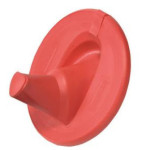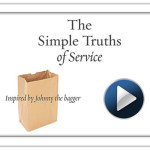 The challenge when it comes to service and service recovery – of any kind, internal or external, personal or professional – is in the answer to this question: When you’re done,would you rather have people say, “That was nice.” or “That was WOW!”? When service and recovery efforts are delivered at the customer’s convenience and the company’s cost (if any), it’s often a “WOW!” But when they’re not done that way, it may (or may not) be “nice” when you’re finished, but it’s definitely not “WOW!”
The challenge when it comes to service and service recovery – of any kind, internal or external, personal or professional – is in the answer to this question: When you’re done,would you rather have people say, “That was nice.” or “That was WOW!”? When service and recovery efforts are delivered at the customer’s convenience and the company’s cost (if any), it’s often a “WOW!” But when they’re not done that way, it may (or may not) be “nice” when you’re finished, but it’s definitely not “WOW!”
Here’s an easy formula for committing to delivering the W-O-W, whether it be at the time of initial service delivery or during service recovery after something’s gone wrong:
W = Your Word. Stand by it. I don’t care if someone promised something they shouldn’t have. If you can do it anyway, do it! If not, ask the customer if there’s something else you can do to make it up to them. If you can’t do that, at least offer them something of value to them. Don’t blame the customer; don’t assume they misunderstood; don’t trash the employee who made a mistake; don’t make excuses. Just stand by your word and make it right.
I bought some flooring and countertops at Home Depot one time. One set of items was offered on a “No-Interest Financing for 6 months” plan; the other offered a plan that deferred interest for an entire year. When I went to check out, a clerk asked if I’d like both sets of items on the one-year plan. I showed him the flyer that clearly did not offer both on that plan, but he said he’d worked there for a very long time and knew that if I bought one on that plan, the other could be included on it, as well.
I asked him if he’d put that in writing (as you can guess, I’ve been burned before, not at that company, but at others). He was surprised, but agreed to write it down and sign it. I went on my way, singing a merry tune about my surprise “gift.”
Flash forward a week or two. I got a call from Home Depot, informing me that a mistake had been made and items not eligible for the one-year plan had inadvertently been added there and needed to be removed and placed on the 6-month plan. Surprise, surprise, the clerk had been wrong. However, after I told them the clerk had said they could both be included and they informed me that “I must have misunderstood” (my all-time favorite pet peeve from customer service reps), I told them I had it in writing.
Dead silence… followed by a request to show them the paper on which it was written. I did and, to their credit, even though I wasn’t technically entitled to that plan for all items, they stood by their employee’s promise and honored it. WOW!
O = Ownership. Take ownership of your own knowledge and skills. Keep learning and growing; keep improving. Never assume! Check it out if even the tiniest scintilla of doubt exists. (By the way, having a flyer that contradicts your understanding of a certain program should create at least a scintilla of doubt in your mind!) Keep learning; ask questions anyway because here’s the rub:
When something goes wrong, the customer is already inconvenienced. But what they really want is for the company to correct the situation at their convenience and the company’s cost… not the other way around! But what often happens is that the situation is eventually corrected… at the company’s convenience and the customer’s cost! The customer has to invest time and effort, often multiple times over, just trying to get the situation corrected. They often then have to pay real money for restocking fees, cancellation fees, or just putting up with the wrong product because the company policy says they can’t return or cancel the item without a penalty.
Don’t get me wrong. Obviously there are times when customers do misunderstand things or simply want to get away with something. That’s human nature – we all know it. But at least avoid punishing honest customers who are victims of an employee’s lack of knowledge by asking them to pay for the employee’s mistake.
W = What-if scenarios. Do them! Proactive thinking can help you create WOWs if you just take a few moments to analyze the system or process, think it all the way through and see if it will play out as you expect it will.
As I was checking out of a store recently, after I’d paid for my items, the clerk stapled a coupon to my receipt. The coupon said, “Get two free greeting cards TODAY with any purchase!” But I had just completed my purchase and was ready to leave. I had no time (or inclination) to go back at that point and pick out two cards, then come back and stand in line again in order to get them free. While the coupon was good until the end of the month, which as only about a week away at that point, that meant I would have to go back in the next week – and buy something else – in order to get my two free cards.
Granted, it’s nice that they offer the coupon at all, but here’s where the experience could have been better than nice – it could have been a WOW!
The clerk could have told me about the coupon before ringing up my purchase, to allow me to use the coupons on that trip – before checking out. Better yet, the store could have put a rack at the front entrance with a big sign announcing that customers could get two free cards with their purchase today, allowing them to get the cards while they were shopping and do it all in one sweep of the store.
So, the next time you really want to WOW your customers, analyze your proposed actions for the WOW factor: Will I keep my WORD? Am I taking OWNERSHIP for the success of myself, my customer, and my company? And am I doing WHAT-IF scenarios up front to ensure that every nuance is considered?
Start with one process, one experience, or one action you plan to take. Analyze it, visualize it, walk through every step to be sure that when you put it into action it will really be the WOW you think it is.
Remember that your service efforts can be nice… but “nice” won’t get you hired, re-hired, or referred through incredible word-of-mouth advertising. “WOW” will. Anyone can create easy and NICE actions. The challenge is that it takes more dedication and work to make the difference that creates a WOW.
Are you up to the challenge?
 My husband Bruce recently had to paint our new fence. So, he borrowed a friend’s paint sprayer, went to the DIY hardware store to buy paint, then tried to pour the paint into the narrow opening for the sprayer… getting paint everywhere because paint doesn’t pour neatly from a can! (Not only that, but anyone who has ever done any painting knows that any time you pour paint from the can, it collects in the lip, so when you put the cover back on, the paint in the lip dries and makes the cover almost impossible to remove at a later date!)
My husband Bruce recently had to paint our new fence. So, he borrowed a friend’s paint sprayer, went to the DIY hardware store to buy paint, then tried to pour the paint into the narrow opening for the sprayer… getting paint everywhere because paint doesn’t pour neatly from a can! (Not only that, but anyone who has ever done any painting knows that any time you pour paint from the can, it collects in the lip, so when you put the cover back on, the paint in the lip dries and makes the cover almost impossible to remove at a later date!)









